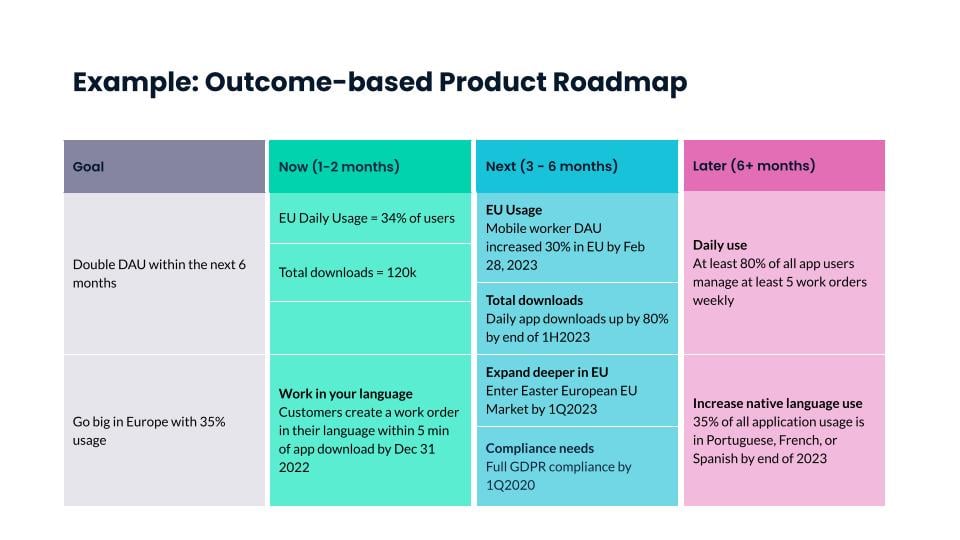Updated: March 24, 2025- 9 min read
One thing that we found to be really helpful is simply saying, what do we care about right now, what's coming next, and what can we think about later?
– Jay Lee, SVP at NBA, on The Product Podcast
If you’ve driven on the highway, you’ve probably seen signs warning when there are curves ahead. They alert drivers to challenging conditions that will require extra attention. In the product world, we know there will be curves. It’s part of doing business! Market conditions, technology, regulations, and the competitor landscape are all subject to change and require constant adjustment.
This is where Now-Next-Later roadmap comes into play. It's an example of a roadmap that signals that curves are ahead, and makes it easy to navigate around each one. By breaking down the backlog into current, imminent, and future tasks, it allows teams to look ahead and pivot with agility.
When the driving conditions get harry, this is the product roadmap you want in the glove compartment!
Product Roadmapping Micro-Certification (PRC)™️
Product School has partnered with Productboard to create a micro-certification on how to build and maintain effective Roadmaps. Enroll for free to learn how to communicate the product vision and strategy to your stakeholders and customers.
Enroll for Free
What Is the Now-Next-Later Roadmap?
The Now-Next-Later roadmap (also known as the Now-Next-Future roadmap or the Now Then Later roadmap) is a strategic framework used in product management to categorize tasks and initiatives into three time-focused segments: Now (immediate tasks that require current attention), Next (top priorities to focus on in the short term), and Later (long-term objectives that shape the overall strategic direction). This method promotes clarity by distinguishing between immediate actions, upcoming plans, and future goals, thereby organizing a product team’s efforts.
Benefits of the Now-Next-Later Roadmap in Product Management
The more you’ve planned ahead, the less your team will be paying attention to what’s happening in the market, with your customers, etc. and all of a sudden they’re delivering things that don’t really “matter” because they don’t reflect the current lived reality of the customer.
– Maggie Crowley, VP of Product at Toast
The primary purpose of the Now-Next-Later roadmap is to streamline the planning and execution processes in product development without losing sight of high-level product strategy. It aids product teams in maintaining a clear focus on what needs to be accomplished now, while also setting the stage for upcoming tasks and long-term objectives.
The Now-Next-Later framework’s superpower is its flexibility, as the roadmap can easily be adjusted to reflect changes in priorities or market conditions. For example, if a competitor releases a new feature that threatens market share, the team can easily update the “next” and “later” initiatives or move priorities up into the “now” category to reflect the current situation.
The Now Then Later roadmap improves communication with stakeholders by clearly outlining what is being worked on now versus what is planned for the future. Furthermore, this roadmap simplifies complex projects into more manageable segments, making it easier for teams to measure progress.
The Core Elements of the Now-Next-Later Framework
The 'Now' Segment: Immediate Priorities and Actions
The 'Now' segment of the Now-Next-Later roadmap focuses on tasks that require immediate attention and execution. These are typically urgent activities crucial for maintaining the product's current operations or meeting short-term objectives.
This section is updated frequently to reflect the fast-paced changes and demands that characterize active product development phases. Emphasizing clear, actionable items, this segment helps teams stay focused and responsive to immediate needs.
The 'Next' Segment: Short-Term Priorities
The 'Next' segment targets what the product team plans to tackle in the near future. Once the ‘Now’ tasks are completed, many of the ‘Next’ initiatives will be moved into the ‘Now’ category.
These are not immediately pressing but are crucial for the product's continued growth and success in the coming months. This section helps align team efforts toward upcoming features, improvements, or market expansions.
The 'Later' Segment: Long-Term Goals and Vision
The 'Later' segment outlines the long-term goals and vision for the product. These are broader objectives planned for the future, intended to guide the strategic direction of the product over the years. This part of the roadmap is less detailed than the 'Now' and 'Next' segments, providing a big-picture view that influences decision-making and prioritization. It helps stakeholders understand the ultimate aspirations of the product, fostering alignment and support for long-term strategies.
As time passes, many of the items in the ‘Later’ segment will be made into concrete, detailed tasks for the ‘Now’ and ‘Next’ segments. Some of the ‘Later’ items will be discarded to reflect changing conditions. This does not mean that the eliminated ‘Later’ items were ill-conceived. Rather, it means that the active pruning and prioritization process is dynamic and held up to scrutiny in order to make the best decisions given the present conditions.
Integrating Now-Next-Later Roadmaps with OKRs
Objectives and Key Results (OKRs) are a goal-setting framework that helps organizations define and track measurable goals and outcomes. In product management, OKRs align team efforts with the company's strategic objectives. They focus on setting ambitious, measurable objectives along with specific, quantifiable results that indicate success.
Integrating the Now-Next-Later roadmap with OKRs involves mapping the immediate (Now), short-term (Next), and long-term (Later) goals of the product roadmap to the broader organizational OKRs. This alignment ensures that each segment of the roadmap not only advances the product's position but also contributes directly to achieving the overarching corporate objectives. For effective integration, follow these steps:
Translate OKRs into Roadmap Items: Break down each Objective and Key Result into actionable roadmap items categorized under Now, Next, and Later.
Prioritization and Alignment: Ensure that the most critical OKRs, or ones that the team is running behind on, are addressed in the 'Now' section, with subsequent OKRs phased into the 'Next' and 'Later' segments.
Review and Adjust: Regularly review both the OKRs and the roadmap to ensure they remain aligned, making adjustments to the roadmap as the organization's priorities evolve or as progress is measured against the set OKRs.
Product School’s Now-Next-Later Roadmap Template
Product Roadmap Template
Download our easy-to-use template to help you create your Product Roadmap.
Get the Template
We partnered with Coda to develop an Outcome-Based Now-Next-Later Roadmap Template that is designed to seamlessly integrate the strategic planning process with measurable outcomes and align the Now-Next-Later framework with company OKRs. This now-next-later template is structured to ensure that every product goal is paired with clear metrics for success through OKRs, distributed across the Now, Next, and Later phases.

Outcome-Based Roadmap Template Features
As you can see above, each row represents a distinct goal of the product roadmap. This structured approach helps break down each goal into actionable segments that are easy to monitor and manage.
Goal Definition: At the beginning of each row, there is a dedicated space to clearly define the goal. This clarity is crucial for aligning the team and stakeholders around what needs to be achieved.
Assigning OKRs to Each Phase:
Now Column: Here, you insert the OKRs that can be measured in the short term. These are urgent key results that the team aims to achieve quickly. Note that in the example above, there are specific metrics listed that correspond to the overall objective in the first column.
Next Column: This column is for OKRs that are up next. They should represent what the team will focus on once the 'Now' objectives are on track or completed.
Later Column: This column focuses on long-term aspirations and the OKRs that measure success toward these goals. These are loftier goals that will take time to achieve. Over the next several months, the team can track its progress toward to the goal and evaluate if the current strategy is bringing them closer to their long-term objective.
Outcome-based roadmaps align with the product vision and, as is explained in the video below, are in step with what the most recent thought leadership in product management recommends for roadmaps.
Benefits of Using the Outcome-Based Roadmap Template
Enhanced Alignment: Aligns daily activities and strategic initiatives with the long-term goals of the organization.
Clear Accountability: Each goal is directly linked to specific OKRs, making it easier to track progress and hold team members accountable.
Strategic Flexibility: The clear division into Now, Next, and Later allows for flexibility and adaptability as priorities shift or as new opportunities and challenges arise.
This template not only simplifies the roadmapping process but also enhances its effectiveness by connecting goals with their outcomes in a visually organized and strategic manner. Whether you're launching new features, entering new markets, or enhancing existing products, this template will guide your team towards achieving measurable success, aligned with your broader business objectives.
When to Use the Now-Next-Later Roadmap (and When Not to Use It)
The Now-Next-Later roadmap is most effective in environments where flexibility and responsiveness are crucial. It is particularly beneficial for:
Dynamic Markets: In industries where market conditions change rapidly, this roadmap helps teams adapt their priorities quickly without losing sight of long-term goals.
Product Development: Ideal for managing the lifecycle of a product, from initial development through to launch and beyond, ensuring that immediate tasks, upcoming features, and future innovations are all aligned and clear.
Growth Phases: During periods of growth, when strategic scaling is necessary, this roadmap can help manage expanding product lines or entry into new markets efficiently.
When Not to Use the Now-Next-Later Roadmap
While versatile, the Now-Next-Later roadmap might not be suitable in certain contexts:
Static or Predictable Environments: For businesses with very stable market conditions and predictable customer demands, a more traditional, linear roadmap might be simpler and more effective.
Small-Scale or Short-Term Projects: If the project scope is limited to short timeframe, the Now-Next-Future roadmap may introduce unnecessary complexity where a straightforward task list or project plan could suffice.
When Comprehensive Detail is Required: This roadmap provides a high-level view, which may not be detailed enough for situations requiring granular task management and scheduling.
Now, Next, Later—the Framework that Helps You Stay on the Ball
…Even when the ball is bouncing all around the court! The Now-Next-Later roadmap offers a flexible and strategic framework for product management, enabling teams to effectively prioritize and execute tasks while aligning with broader organizational goals. By segmenting tasks into immediate, short-term, and long-term categories, this roadmap ensures clarity and focus at every stage of product development.
Integrating the framework with OKRs enhances accountability and drives measurable outcomes, making it an indispensable tool for product leaders navigating dynamic markets. Putting a Now-Next-Later roadmap template to good use can transform your product management approach, leading to more organized, responsive, and successful product outcomes.
Product OKR Template
Use this Product OKR template to set and track your OKRs (Objectives and Key Results). Align your team’s daily tasks with product and company strategy!
get free template
Updated: March 24, 2025





